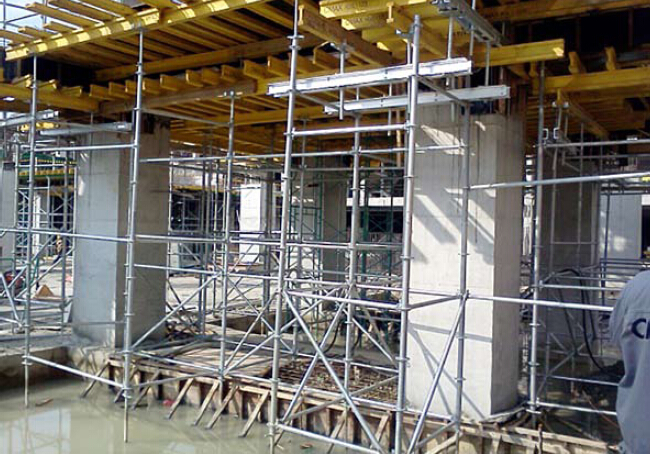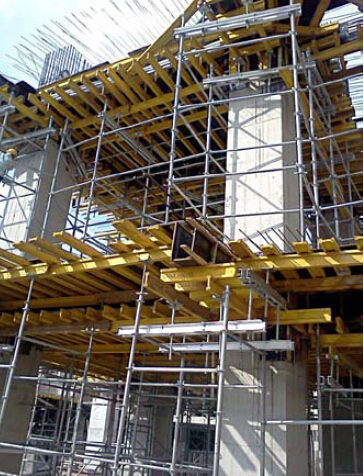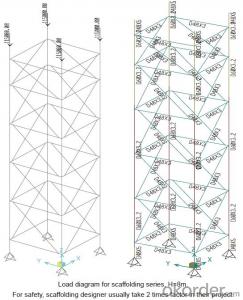Ring-lock Scaffolding accessories for formwork and scaffolding systems
- Loading Port:
- Tianjin
- Payment Terms:
- TT OR LC
- Min Order Qty:
- 50 m²
- Supply Capability:
- 1000 m²/month
OKorder Service Pledge
Quality Product, Order Online Tracking, Timely Delivery
OKorder Financial Service
Credit Rating, Credit Services, Credit Purchasing
You Might Also Like
Ring-lock Scaffolding
A support system for construction, ownsadvantages of both cup-lock scaffolding andshoring tower.
It is in the development direction of new typescaffolding.
It is widely used in buildings, bridges, tunnels etc..
Characteristics:
◆ Easy to storage and transportation
◆ High degree of standardization
◆ Easy and quick erection
◆ Excellent stability and bearing capacity


- Q:Can steel formwork be used for projects with limited formwork assembly time?
- Yes, steel formwork can be used for projects with limited formwork assembly time. Steel formwork is known for its durability and strength, making it a suitable choice for projects that require quick assembly and demobilization. Unlike traditional timber formwork, steel formwork can be easily assembled and dismantled, reducing the overall construction time. Additionally, steel formwork is reusable, allowing for cost savings and increased efficiency on future projects. Overall, steel formwork is a reliable solution for projects with limited formwork assembly time.
- Q:How does steel formwork affect the overall strength of the structure?
- Steel formwork can greatly affect the overall strength of a structure in a positive way. Steel is known for its exceptional strength and durability, making it an ideal material for formwork. When used in construction, steel formwork provides a rigid framework that supports the weight of the concrete during the pouring and curing process. The use of steel formwork ensures that the concrete is properly contained and supported, preventing any deformation or collapse during the hardening phase. This is crucial for maintaining the structural integrity of the building, as any failure in the formwork can lead to serious consequences. Steel formwork also allows for greater flexibility in design, as it can be easily customized and shaped according to the desired structure. This versatility enables engineers and architects to create complex and innovative designs without compromising the strength of the building. Moreover, steel formwork has a longer lifespan compared to other types of formwork materials, such as wood or plastic. Its durability ensures that the formwork can be reused multiple times, reducing construction costs and minimizing waste. This not only makes it cost-effective but also contributes to sustainability in the construction industry. In summary, steel formwork positively impacts the overall strength of a structure by providing a robust and reliable support system for the concrete. Its strength, durability, and flexibility make it an excellent choice for ensuring the structural integrity and longevity of buildings.
- Q:How does steel formwork handle formwork stripping?
- Steel formwork handles formwork stripping by providing a strong and durable framework that can withstand the forces involved in the removal of the formwork. Steel formwork is designed to be rigid and stable, allowing for easy and efficient stripping of the formwork after the concrete has cured. The stripping process involves removing the formwork panels or components from the concrete structure. With steel formwork, this can be achieved by loosening the fasteners or connectors that hold the formwork in place. Steel formwork is typically assembled using bolts, nuts, or other mechanical connectors, which can be easily undone during the stripping process. Steel formwork also offers the advantage of smooth and clean surfaces, reducing the risk of concrete sticking to the formwork during pouring and curing. This makes the stripping process much easier, as the concrete is less likely to adhere to the steel surface. Additionally, the smooth surface of steel formwork allows for easy cleaning and maintenance, ensuring its longevity and reusability. Furthermore, steel formwork is known for its high strength and load-bearing capacity, enabling it to support the weight of the concrete during the pouring and curing stages. This strength also translates to the stripping process, as the steel formwork can withstand the pressure and forces involved in removing the formwork without deforming or collapsing. Overall, steel formwork is a reliable and efficient solution for handling formwork stripping. Its strength, durability, and ease of use make it a popular choice in construction projects where formwork needs to be removed quickly and safely.
- Q:Can steel formwork be used for both manual and mechanical concrete pouring?
- Indeed, both manual and mechanical concrete pouring can utilize steel formwork. Renowned for its robustness and sturdiness, steel formwork is apt for handling the immense pressure and weight of concrete, regardless of the pouring method employed. It furnishes a steadfast and inflexible framework that endures the strains exerted during the pouring and setting of concrete. Moreover, steel formwork is adaptable and can be effortlessly modified or reconstructed to accommodate diverse configurations and dimensions of concrete structures. Consequently, it is frequently employed in construction ventures that employ both manual and mechanical concrete pouring techniques.
- Q:What are the different types of steel used in formwork construction?
- Formwork construction utilizes various types of steel, each possessing distinct characteristics and applications. 1. Mild Steel: The most frequently employed steel in formwork construction, mild steel offers affordability, availability, and ease of handling. It is suitable for numerous formwork applications, boasting commendable strength and durability. 2. High Tensile Steel: Distinguishing itself from mild steel, high tensile steel exhibits superior strength and tensile properties, rendering it ideal for robust formwork structures. Its ability to resist bending and deformation under heavy loads makes it particularly fitting for extensive construction projects. 3. Reinforcing Steel: Also referred to as rebar, reinforcing steel reinforces concrete structures in formwork construction. Typically composed of carbon steel, it comes in various grades and sizes. Reinforcing steel is employed to enhance concrete's tensile strength, diminish cracking, and prevent structural failure. 4. Stainless Steel: When prioritizing resistance to corrosion, formwork construction turns to stainless steel. This material excels in environments with harsh conditions or exposure to corrosive substances. Its exceptional resistance to corrosion results in a long-lasting and durable choice for formwork construction. 5. Alloy Steel: Utilized in formwork construction for its augmented properties, alloy steel combines with other elements to enhance its characteristics. This type of steel is commonly employed for its high strength, toughness, and resistance to wear and tear. Formwork systems requiring outstanding performance and durability often rely on alloy steel to withstand substantial loads. Ultimately, the selection of steel for formwork construction hinges upon project-specific requirements, encompassing load-bearing capacity, durability, and corrosion resistance. The appropriate type of steel must be chosen to guarantee the safety and longevity of the formwork structure.
- Q:How does steel formwork affect the overall cost of concrete placement?
- Steel formwork can have a significant impact on the overall cost of concrete placement. While steel formwork may initially have a higher upfront cost compared to other types of formwork, it offers several advantages that can result in cost savings in the long run. Firstly, steel formwork is durable and can be reused multiple times, unlike traditional wooden formwork that often needs to be replaced after a few uses. This reusability reduces the need for purchasing new formwork for each concrete placement, resulting in cost savings over time. Additionally, steel formwork provides a smooth and consistent finish to the concrete surface, reducing the need for extensive surface preparation and finishing work. This can decrease labor costs and save time during the concrete placement process. Furthermore, steel formwork offers better structural stability, ensuring a higher quality concrete placement with minimal defects. This reduces the chances of costly rework or repairs, thereby saving money in the long term. Moreover, steel formwork allows for a faster construction process due to its ease of assembly and disassembly. This can result in reduced labor costs and increased productivity, ultimately leading to lower overall construction expenses. Lastly, steel formwork is highly resistant to moisture and weather conditions, reducing the risk of damage and increasing its lifespan. This durability translates to long-term cost savings as there is no need for frequent replacements or repairs. In conclusion, while steel formwork may have a higher initial investment, its durability, reusability, superior finish, structural stability, construction speed, and resistance to damage make it a cost-effective choice for concrete placement. The long-term savings in labor, materials, and repairs outweigh the initial cost, making steel formwork a wise investment for construction projects.
- Q:What are the common challenges faced during steel formwork transportation?
- During steel formwork transportation, there are several common challenges that may arise. One of the main challenges is the weight and size of the steel formwork. Steel formwork can be heavy and bulky, making it difficult to transport and handle. This can require special equipment and vehicles to safely transport the formwork to the desired location. Another challenge is the potential for damage or deformation during transportation. Steel formwork needs to be transported in a way that prevents any bending, twisting, or scratching. Improper handling or inadequate securing of the formwork can lead to damage, which may affect its performance and durability. The logistics of transportation can also be a challenge. Coordinating the delivery of steel formwork to construction sites can be complex, especially when multiple projects are ongoing simultaneously. Ensuring that the formwork arrives on time and in the correct quantities requires careful planning and coordination. Furthermore, the terrain and road conditions can pose challenges during transportation. If the construction site is located in a remote or difficult-to-access area, the transportation of steel formwork can be more challenging. Poor road conditions, narrow access roads, or steep inclines may require additional measures to ensure safe transportation. Lastly, safety considerations are paramount during steel formwork transportation. The weight and size of the formwork can pose risks to the personnel involved in loading, unloading, and securing the formwork. It is essential to follow proper safety protocols and provide appropriate training to the workers involved to minimize the risk of accidents or injuries. Overall, the common challenges faced during steel formwork transportation include the weight and size of the formwork, potential for damage or deformation, logistics of delivery, terrain and road conditions, and safety considerations. By addressing these challenges effectively, the transportation process can be executed smoothly, ensuring the timely and safe delivery of steel formwork to construction sites.
- Q:What are the considerations when designing steel formwork for retaining walls?
- When designing steel formwork for retaining walls, several considerations need to be taken into account. First, the formwork should be strong enough to withstand the pressure exerted by the wet concrete, ensuring it does not collapse or deform during the pouring process. Additionally, the formwork should be able to resist the lateral pressure exerted by the soil behind the retaining wall. Proper bracing and reinforcement are crucial to ensure stability. The formwork should also be designed to allow for easy removal once the concrete has cured, considering factors such as the type of release agent used and the desired finish of the wall. Lastly, considerations should be given to factors such as cost, time, and ease of assembly and disassembly, as these can impact the overall efficiency and effectiveness of the formwork.
- Q:Can steel formwork be used for both horizontal and vertical structures?
- Yes, steel formwork can be used for both horizontal and vertical structures. Steel formwork is versatile and can be easily adjusted and assembled to meet the requirements of different construction projects, whether they involve horizontal slabs or vertical walls and columns. Its strength and durability make it suitable for a wide range of applications in various types of structures.
- Q:Can steel formwork be used for tunnel portals?
- Yes, steel formwork can be used for tunnel portals. Steel formwork is a versatile and durable option for constructing tunnel portals due to its strength and ability to withstand the forces and pressures exerted by the surrounding soil and rock. Steel formwork can be fabricated to any shape and size required for tunnel portals and can be easily assembled and disassembled, making it a practical choice for tunnel construction. Additionally, steel formwork provides a smooth surface finish, which is important for tunnel portals as it allows for efficient flow of traffic and reduces the risk of damage to vehicles. Overall, steel formwork is a suitable and commonly used method for constructing tunnel portals.
1. Manufacturer Overview |
|
|---|---|
| Location | |
| Year Established | |
| Annual Output Value | |
| Main Markets | |
| Company Certifications | |
2. Manufacturer Certificates |
|
|---|---|
| a) Certification Name | |
| Range | |
| Reference | |
| Validity Period | |
3. Manufacturer Capability |
|
|---|---|
| a)Trade Capacity | |
| Nearest Port | |
| Export Percentage | |
| No.of Employees in Trade Department | |
| Language Spoken: | |
| b)Factory Information | |
| Factory Size: | |
| No. of Production Lines | |
| Contract Manufacturing | |
| Product Price Range | |
Send your message to us
Ring-lock Scaffolding accessories for formwork and scaffolding systems
- Loading Port:
- Tianjin
- Payment Terms:
- TT OR LC
- Min Order Qty:
- 50 m²
- Supply Capability:
- 1000 m²/month
OKorder Service Pledge
Quality Product, Order Online Tracking, Timely Delivery
OKorder Financial Service
Credit Rating, Credit Services, Credit Purchasing
Similar products
New products
Hot products
Hot Searches
Related keywords
























